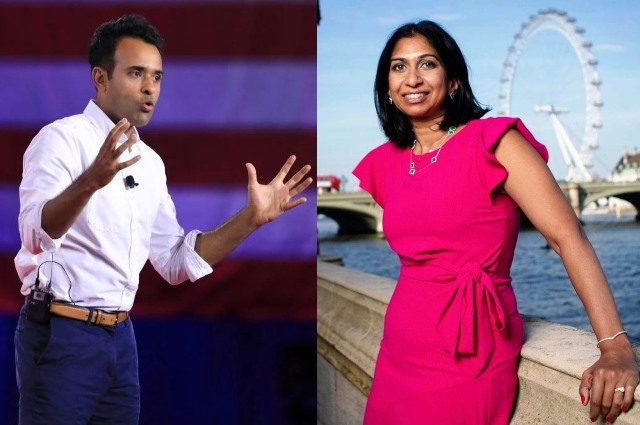For a brief while in 2015-16, a swathe of the Indian media went nearly hysterical in its fervour to cover Bobby Jindal’s campaign to run for US President as a Republican candidate. That campaign didn’t last long because Jindal soon dropped out of the race but the pronounced enthusiasm with which the Indian media tracked his campaign was noteworthy. Jindal was the son of Indian immigrants and that Indian connection seemed to mean that what he did was newsworthy to the Indian media and their target audiences. To Jindal, it didn’t mean a thing. In fact, he didn’t give a fig for being of Indian origin. Born to immigrant Hindu parents (his Indian name is Piyush), he had not only changed his name to a western sounding one but also converted to Christianity, and, at least during his campaign, assiduously distanced himself from his Indian roots.
Much of the Indian diaspora that could vote in the US usually does so for the Democrats and not the Republicans so they were neither his vote bank nor did he target them. His target was the right-leaning Middle American voters. Yet, in India, we adopted him as one of us despite the fact that he himself all but shunned his roots. Famously, a newspaper quoted him then as saying that he did not believe in hyphenated identities such as Indian-American and that his parents came to the US from India four decades ago “to become Americans and not Indian-Americans”.
There are not very many people of Indian origin high up in American politics but the numbers are growing. Kamala Devi Harris, the incumbent US vice-president and a Democrat, is the daughter of an Indian mother and a Jamaican-American father. Nikki Haley (whose birth name, which she has ditched, is Nimarata Randhawa) was born to Sikh parents, and is a former governor of South Carolina, and is now running for President as a Republican. She too became a Christian and shuns her Sikh origins. In 2001 she reportedly listed her race as “white” on her voter registration card.
One of Haley’s rivals in the race for getting the Republican nomination is Vivek Ramaswamy. A 38-year-old biotech entrepreneur who appears to have surfed the waves of the Great American Dream with perfection, Ramaswamy is a millionaire, a vegetarian, and a Hindu, but whose right-leaning views veer more towards Donald Trump’s than most of the others who are vying to be nominated as the Republican candidate. Ramaswamy distances himself from being an Indian-American and has hardline views that call for reducing US’s involvement in international conflicts such as the one in Ukraine or in the Middle East and for tightening the policies on immigration.
There are similar examples of Indian origin politicians in the UK, whose Conservative Prime Minister Rishi Sunak, himself is of Indian origin. Sunak’s government was recently rocked by a controversy when his (recently sacked) home secretary, Suella Braverman, also of Indian origin, faced criticism for her controversial comments on asylum seekers, homeless people, and pro-Palestinian protests. She also accused the Metropolitan Police in London of bias in their action against protestors. Another former Indian-origin UK home secretary, Priti Patel, also of the Conservative Party, had to resign in 2022 after a series of controversies. Patel had taken a very hard stance against immigrants and asylum seekers, including a now-aborted plan to deport them to a third country.
Both in the US and the UK there is a rise of second generation Indian-origin politicians who are born in those countries. This is akin to what is happening in other fields: business and industry, professional disciplines, and so on.
Many ascribe this to what is described as the “model minority myth”. It is a sociological phenomenon that refers to the stereotype of some minority groups, particularly in the US, and pertaining usually to Asian Americans including those of Indian origin. These are successful, well-adjusted, self-reliant, and well-assimilated groups that do not need a helping hand in terms of economic aid or social assistance.
The concept of “model minority myth” originated in the US in the 1960s and 70s when a different kind of immigrant emerged. For instance, the formally educated Indians such as graduate engineers and doctors who migrated to the US for higher studies, completed those, and then stayed on to build successful professional careers. The phrase was used to compare and contrast them with other minority groups such as African-Americans and Latinos.
The model minority myth has been used as a simplistic way of discriminating and neglecting marginalised minority communities. A crude explanation of how it is used is this: by propping up instances of, say, successful Indian-origin or Chinese-origin minorities as a model and questioning why other immigrant communities are not able to emulate them. This sort of thing oversimplifies the issues of race, circumstances of immigration, socioeconomic class privileges, and many other differences.
However, the emerging breed of Indian-origin politicians in the US and UK with pronounced right-wing views and often pandering, as Republican presidential aspirant Ramaswamy does, to middle America’s voters, or as Braverman or Patel do to the more hardline conservative sections of the British electorate, could be described as examples of model minorities.
Consider this: what would the backlash against a white British native-origin politician be if he or she said the same things that Braverman did? Would it not be more severe? Or, if the consistently “anti-woke” statements that Ramaswamy makes were made by, say, one of his white rivals in the Republican Party aspiring for nomination as presidential candidate? A friend in London joked the other day that Braverman or before her, Patel, were doing or saying things that their party leaders probably wanted to do but couldn’t because of the backlash that they would face. In other words, the Ramaswamys, Bravermans, and Patels, were willing to be convenient pawns, albeit of the “model minority” variety.
For more details visit us: https://lokmarg.com/
